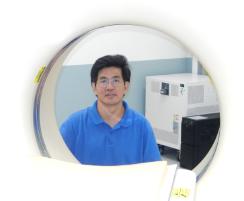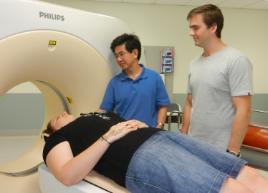Helping medical imaging technology move with the times
Published on 29 Mar, 2012
Media Contact:For Immediate Release
The old-style X-ray has been overtaken by amazing techniques for showing the insides of patients, thanks to modern technology.
PET scans (nothing to do with pets) use tiny amounts of radioactive chemicals which absorb into body tissue to enhance images. In contrast, CT scans (known as CAT scans but nothing to do with cats) show computer-enhanced images of X-rays, while MRIs use huge magnets to reveal detail within soft tissues.

Dr Victor Zhou with a CT Scanner at CQUniversity Mackay
Click here to View/Download full-sized Image
All these wonderful advancements are only as good as the ability of the patient to stay still during the scan.
This can be tricky for children and difficult for patients with dementia and Parkinson's disease symptoms, and it's downright impossible when trying to get internal images of conscious animals for scientific research.
Solutions rely on bringing together an understanding of the physics at play, while developing software and hardware to work better together.
That goal is being worked on in an unlikely setting, nestled beside the canefields of Mackay, in coastal Queensland.

Dr Victor Zhou describes his research to students Katrina Ryan and Josh Field
Click here to View/Download full-sized Image
Former prize-winning Chinese inventor Dr Victor Zhou has been developing his research credentials in the field of precision technology for around two decades. He's now a Lecturer in Medical Physics for CQUniversity. Dr Zhou is based in Mackay because that's now the headquarters for the University's medical imaging programs and laboratories.
"Any movement of a patient during imaging process (scan) can corrupt the images," Dr Zhou says.
"Our motion compensation technique is to monitor the movement of patients during the scan. We can correct corruption of the image caused by patient movement in the image post-processing, using computing software.
"This technique will broaden the scope of imaging technologies."
LINK also to
Unique sonography program taught out of a Sydney CBD high-rise
From Outback to CBD, Lucy's a multi-skilled sonographer
ENDS

